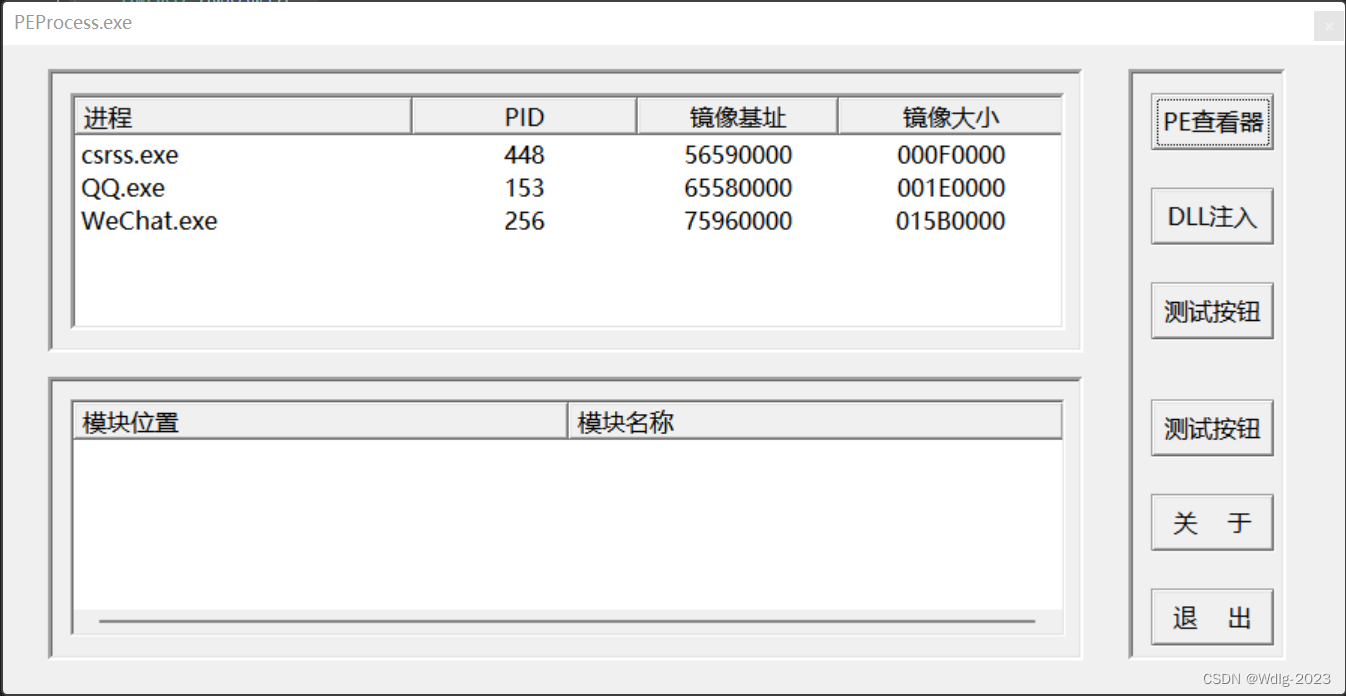Ansible自动化部署工具|各个模块的使用
- 一、自动化运维工具—Ansible
- 二、安装Ansible
- 查询webserver组中主机的日期
- 三 Ansible常用模块
- (1) ansible命令行模块
- (2) command模块
- (3) shell模块
- (4) cron模块
- (5) user模块
- (6) group模块
- (7) copy模块
- (8) file模块
- (9) ping模块
- (10) service/systemd模块
- (11) Shell模块
- (12)script模块
- (13)yum模块
- (14)setup模块
- (15) hostname模块
- 四、inventory主机清单
- 4.1 inventory介绍
- 4.2 inventory中的变量
- 4.3 主机变量
- 4.4 组变量
- 4.5 嵌套组
一、自动化运维工具—Ansible
1、运维工具特点
Ansible 与 Saltstack 均是基于 Python 语言开发,Ansible 只需要在一台普通的服务器上运行即可,不需要在客户端服务器上安装客户端。因为 Ansible 是基于 SSH 远程管理,而Linux服务器大都离不开SSH,所以Ansible不需要为配置工作添加额外的支持。
Ansible 安装使用非常简单,而且基于上千个插件和模块实现各种软件、平台、版本的管理,支持虚拟容器多层级的部署。很多读者在使用 Ansible 工具时,认为 Ansible比 Saltstatck 执行效率慢,其实不是软件本身慢,是由于 SSH 服务慢,可以优化 SSH 连接速度及使用 Ansible 加速模块,满足企业上万台服务器的维护和管理。
2、Ansible运维工具原理
Ansible分为控制端和被控制端,主要是基于SSH协议去管理客户端,被控制端是不需要安装agent插件的Ansible会读取控制端的host文件 ,根据文件中定义的IP列表信息,调取本地的各个模块对被控端机器实现批量、并发的配置管理和维护,如果任务比较复杂可以写成PlayBook剧本进行分发管理。
自动运维管理工具优点
轻量级,更新时,只需要在操作机上进行一次更新即可;
采用 SSH 协议;
不需要去客户端安装 agent;
批量任务执行可以写成脚本,而且不用分发到远程就可以执行;
使用 python 编写的,维护更简单;
支持 sudo 普通用户命令;
去中心化管理。
3、Ansible自动化运维工具流程
(1)加载自己的配置文件,默认/etc/ansible/ansible.cfg
(2)查找对应的主机配置文件,找到要执行的主机或组
(3)加载自己对应的模块文件,如command yum ping
(4)通过ansible将模块命令生成对应临时py文件(pyhton),并将该文件传输至远程服务器上
(5)对应执行用户的家目录的.ansible/tmp/xxx/xxxx.py文件
(6)给文件+执行权限
(7)执行并返回结果,删除临时文件,sleep 0 退出
二、安装Ansible
管理端Ansible:192.168.10.10被管理端:192.168.10.20192.168.10.30部署Ansible自动化运维工具
yum install -y epel-release
#安装epel-release
yum install -y ansible
#安装ansible
#配置文件位置:/etc/ansible/ansible
#hosts文件位置:/etc/ansible/hosts
vim /etc/ansible/hosts
#编辑hosts文件添加被管理的机器,内容如下
[webservers]
192.168.10.20
[dbservers]
192.168.10.30
#[webservers]为一个组,组内2个服务器,添加完毕保存退出
ssh-keygen
#生成公钥,输入命令输入4个回车即可
cd ~/.ssh
sshpass -p '123123' ssh-copy-id root@192.168.10.20
sshpass -p '123123' ssh-copy-id root@192.168.10.30
#进入生成的公钥路径将公钥传输给备管理的服务器,传输需要输入每台备管理服务的root密码
ansible ansible-doc -l
#安装完毕,此命令可以查看有哪些ansible模块,按q退出
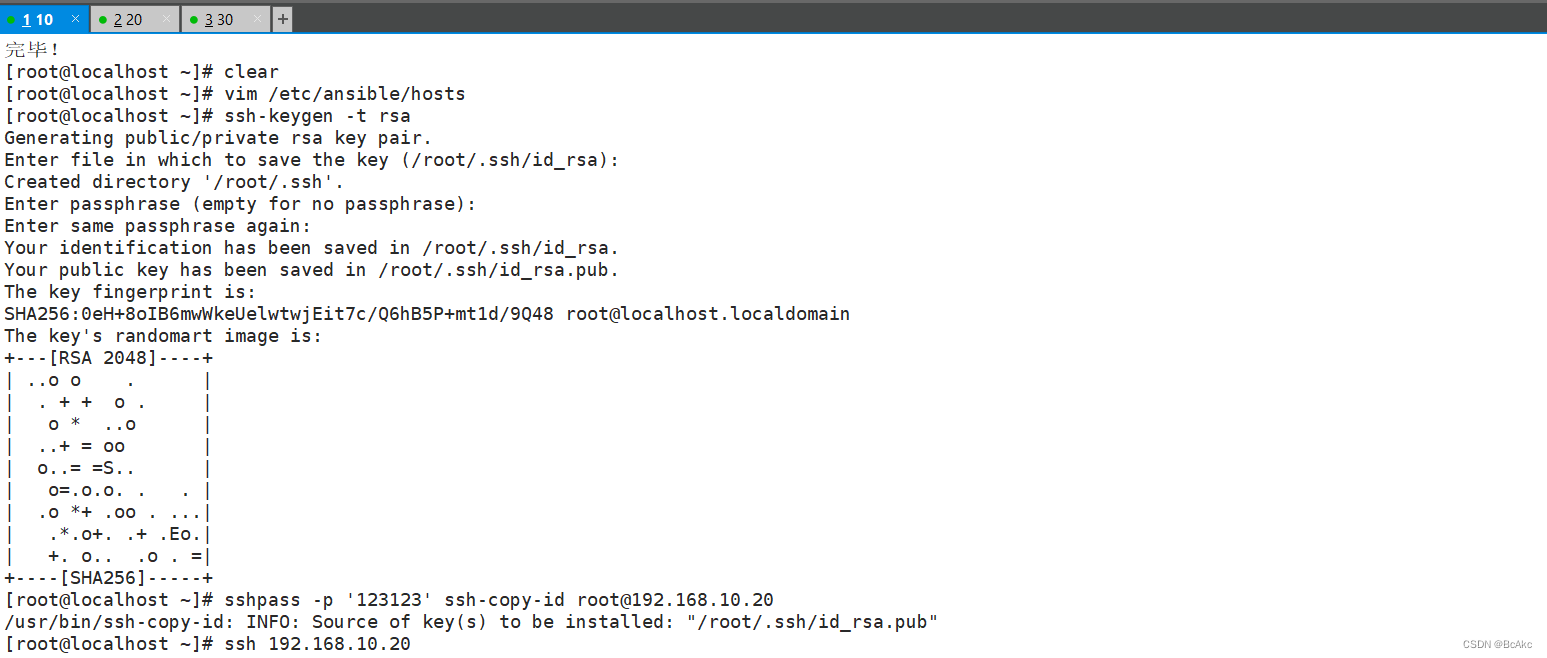


查询webserver组中主机的日期
ansible all -m command -a 'date' #查询所有
ansible dbservers -m command -a 'date'
ansible webservers -m command -a 'date'

三 Ansible常用模块
(1) ansible命令行模块
命令格式:ansible <组名>/ip -m <模块> -a<参数列表>
ansible-doc -s 模块
-s列出指定模块的描述信息和操作动作
(2) command模块
#此模块不能使用管道符和重定向,指定模块默认为commend模块
举例:ansible webservers -m command -a 'date'
#调用command模块在192.168.10.10服务器上执行ls命令,若不指定则默认为command模块

(3) shell模块
#用远程主机的shell进程,打开一个子shell进行命令操作,支持管道符和重定向
举例:ansible webservers -m shell -a 'ifconfig ens33 |awk "NR==2{print \$2}"'
ansible all -m shell -a 'ifconfig ens33 |awk "NR==2{print \$2}"'
#提取webservers组中的所有ip地址,注意双引号不识别变量所以要加转义符

(4) cron模块
#远程主机定义计划任务,2种状态present(添加)和absent(移除),默认为present。
常用参数:minute/hour/day/month/weekday:分/时/日/月/周
job:任务计划要执行的命令
name:任务计划的名称
举例:ansible webservers -m cron -a 'name=crontest hour="*/12" day="*/1" job="/usr/bin/echo cron test " ' ansible webservers -m cron -a "name=crontest state=absent"


(5) user模块
#用户管理模块
常用参数:name:用户名;shell:用户默认shell;uid:指定用户uid;group:指定用户基本组
state:账户状态present增加/absent删除;system:是否为系统用户yes/no;move_home:yes/no若创建用户的家目录存在是否移动;remove:yes/no当state=absent时是否删除家目录;passwd:指定用户的密码;comment:用户的注释信息
举例:
ansible webservers -m user -a 'name="crontest" uid="10086" group="root"'ansible webservers -m user -a 'name=crontest state=absent remove=yes'

(6) group模块
#用户组模块
常用参数: name:组名称 gid:组id system:是否为系统组
(7) copy模块
#复制文件或输出内容到被控制服务器上
常用参数:
mode:指出复制时,目标文件的权限
owner:指出复制时,目标文件的属主(对面无此组或此主会报错)
group:指出复制时,目标文件的属组
dest=‘路径’:目标文件路径
src=‘路径’:源文件路径
content=‘字符串内容’:将字符串内容复制到到目标文件中,等于重定向即覆盖,不能与src同用
举例: ansible dbservers -m copy -a 'src=/etc/fstab dest=/opt/fstab.bak'ansible dbservers -a 'cat /opt/fstab.bak'ansible webservers -m copy -a 'content="123456" dest=/opt/a.txt'ansible webservers -a 'cat /opt/a.txt'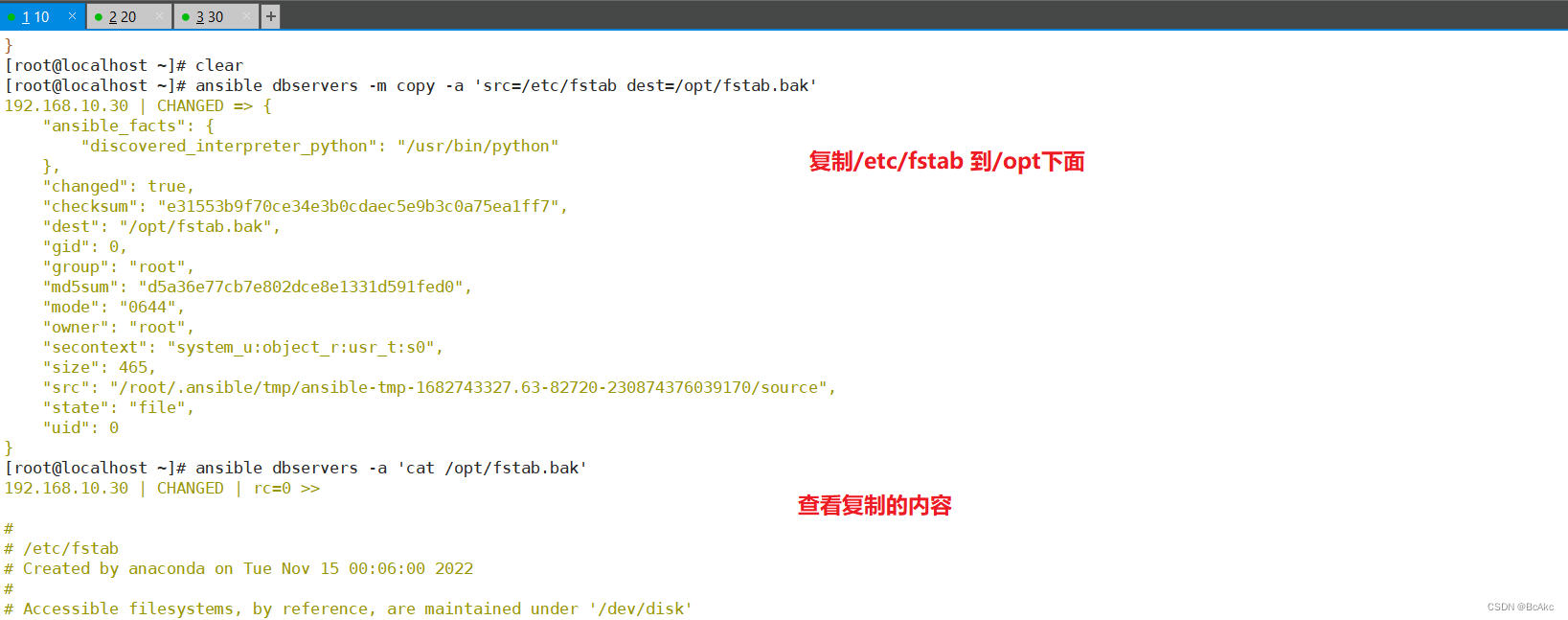
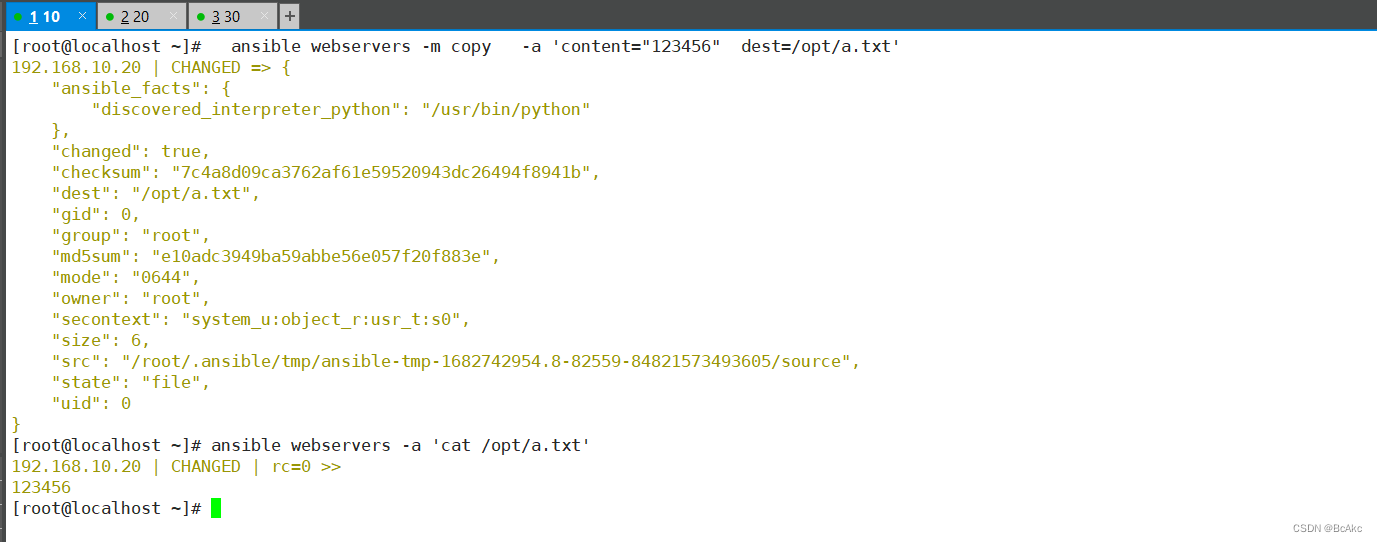
(8) file模块
文件属性管理模块
常用参数:owner:文件的属主;group:文件属组;mode:文件权限;path:文件路径
指定的属主和属组不存在会报错
举例:
ansible dbservers -m user -a 'name=dbservers system=yes'
ansible dbservers -m file -a 'owner=dbservers group=dbservers mode=600 path=/opt/fstab.txt'创建一个boa的文件,并添加软连接
ansible dbservers -m copy -a 'content="boa is good student" dest=/opt/boa.txt'
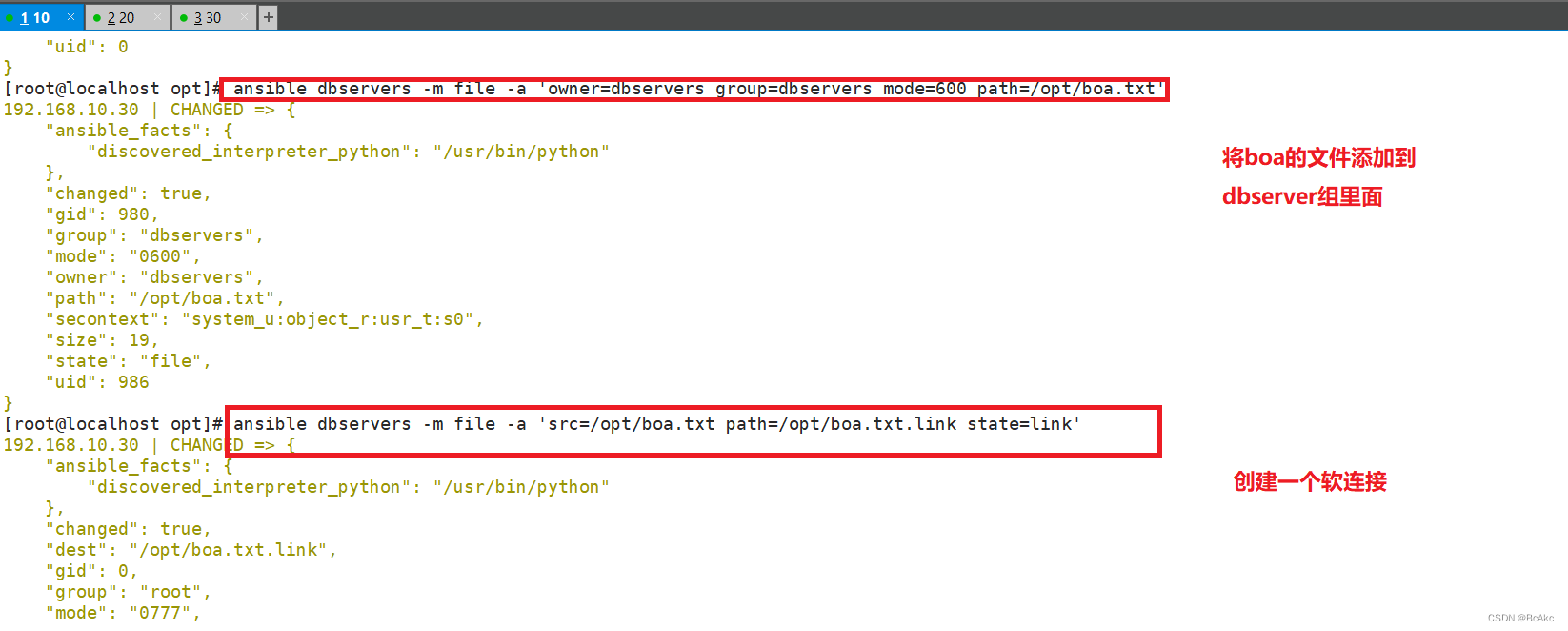ansible dbservers -m file -a 'src=/opt/boa.txt path=/opt/boa.txt.link state=link'
ansible dbservers -a 'ls -l /opt'
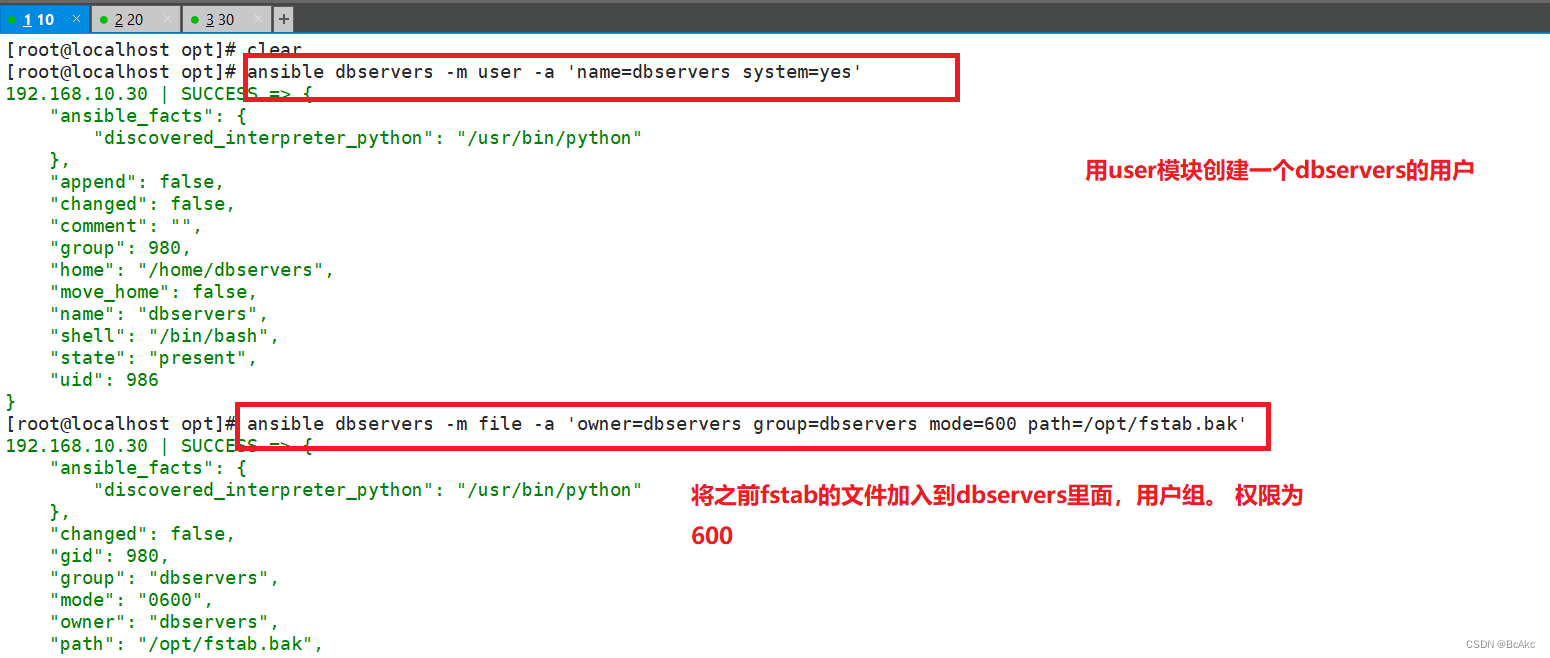

(9) ping模块
检测ansible与被控端的网络连通性
举例:
ansible webservers -m ping ansible all -m ping

(10) service/systemd模块
用于管理远程主机上的管理服务的运行状态
在192.168.10.20和192.168.10.30上安装httpd
ansible dbservers -a 'systemctl status httpd'
ansible dbservers -m service -a 'enabled=true name=httpd state=started'
回到dbservers192.168.10.30主机验证
systemctl status httpd
systemctl is-enabled httpd
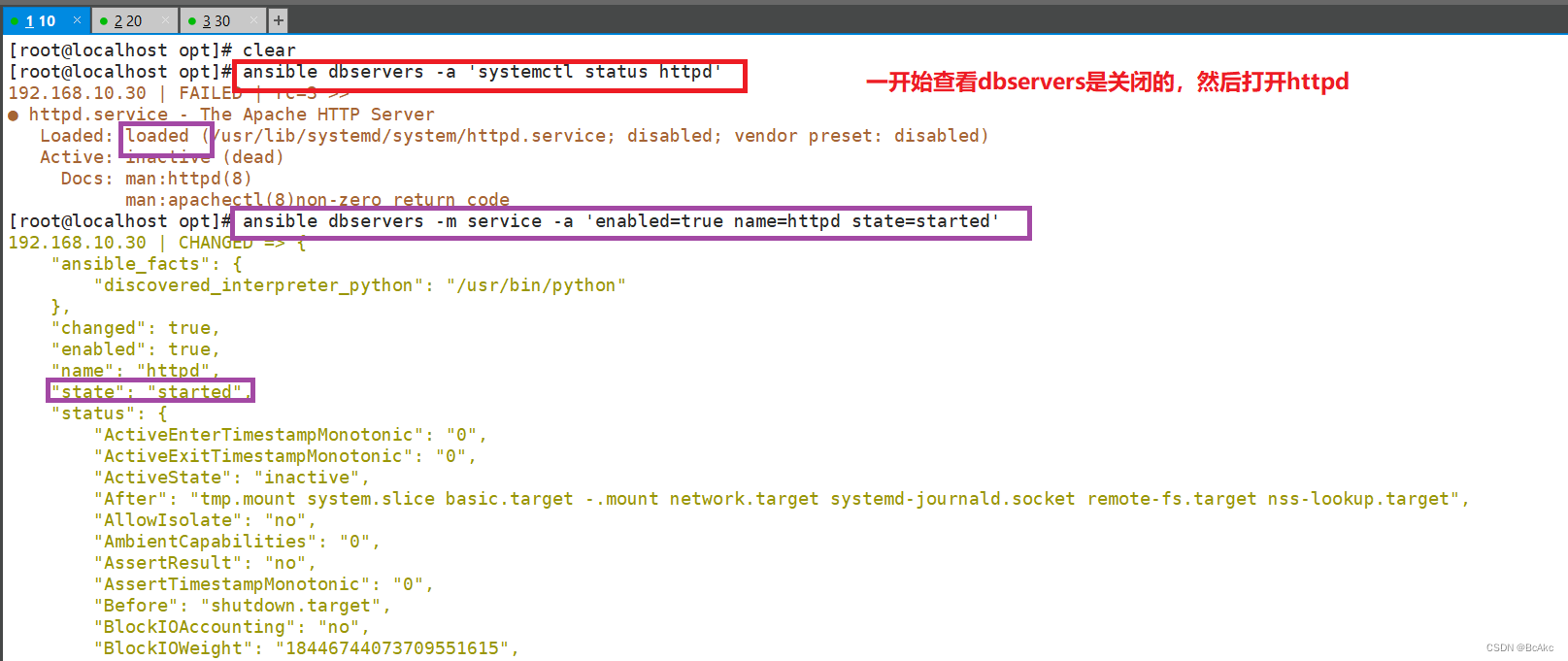
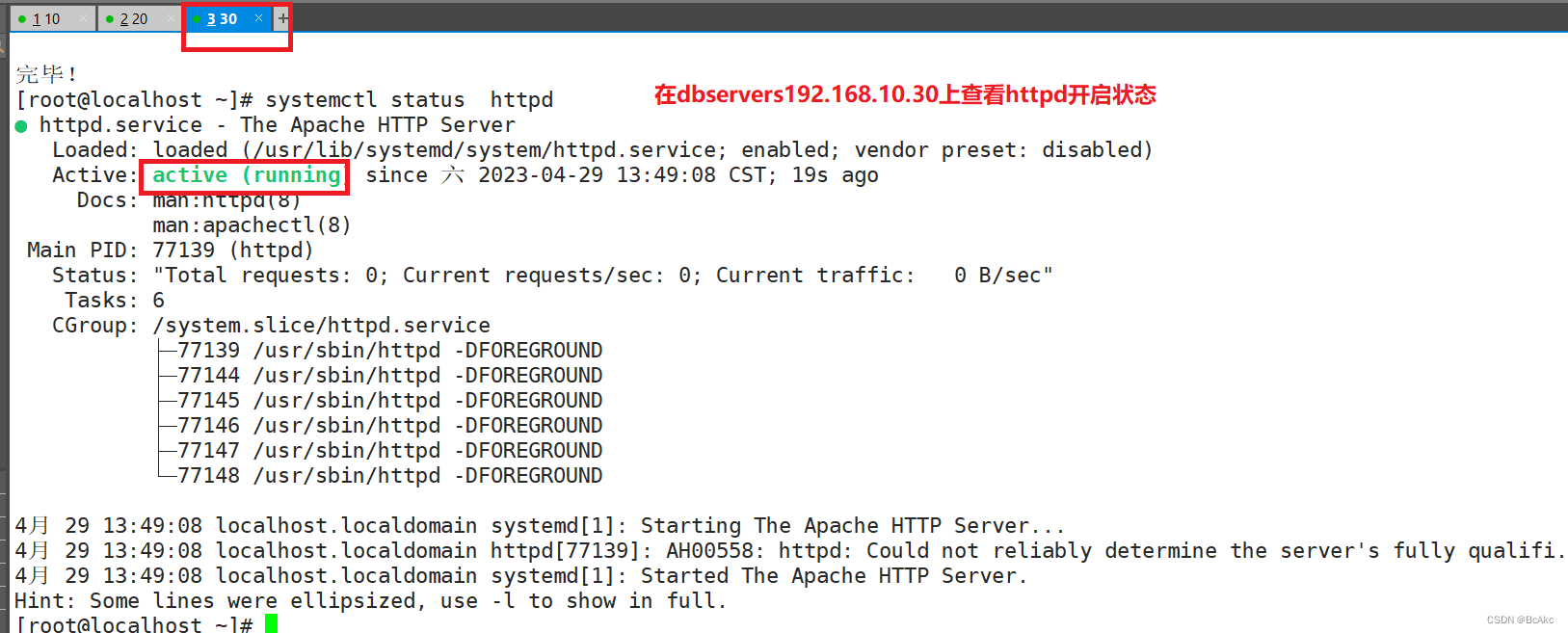
(11) Shell模块
在远程主机执行命令,相当于调用远程主机的shell进程,然后再该shell下打开一个子shell运行命令
ansible dbservers -m user -a 'name=boa'
ansible dbservers -m shell -a 'echo 123123 | passwd --stdin boa'
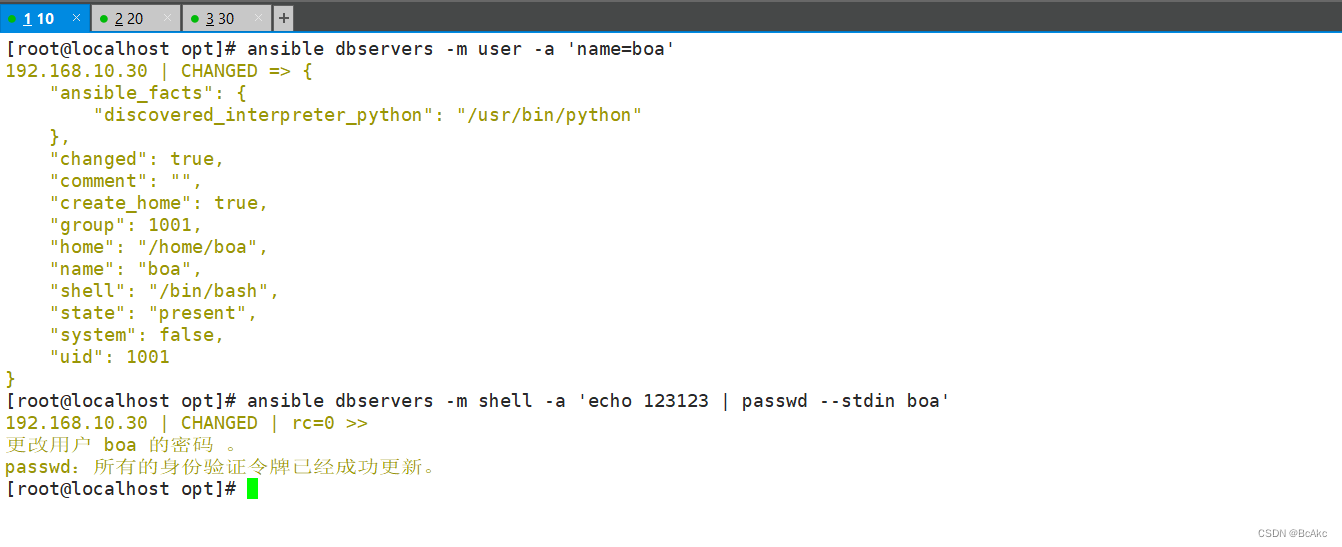
(12)script模块
实现远程批量运行本地的shell脚本
ansible服务器:
vim /opt/test.sh
#编写/下的test.sh脚本内容如下
#!/bin/bash
echo "this is test" >/opt/script.txt
chmod +x /opt/test.sh
ansible webservers -m script -a "/test.sh"
ansible webservers -a 'cat /opt/script.txt'
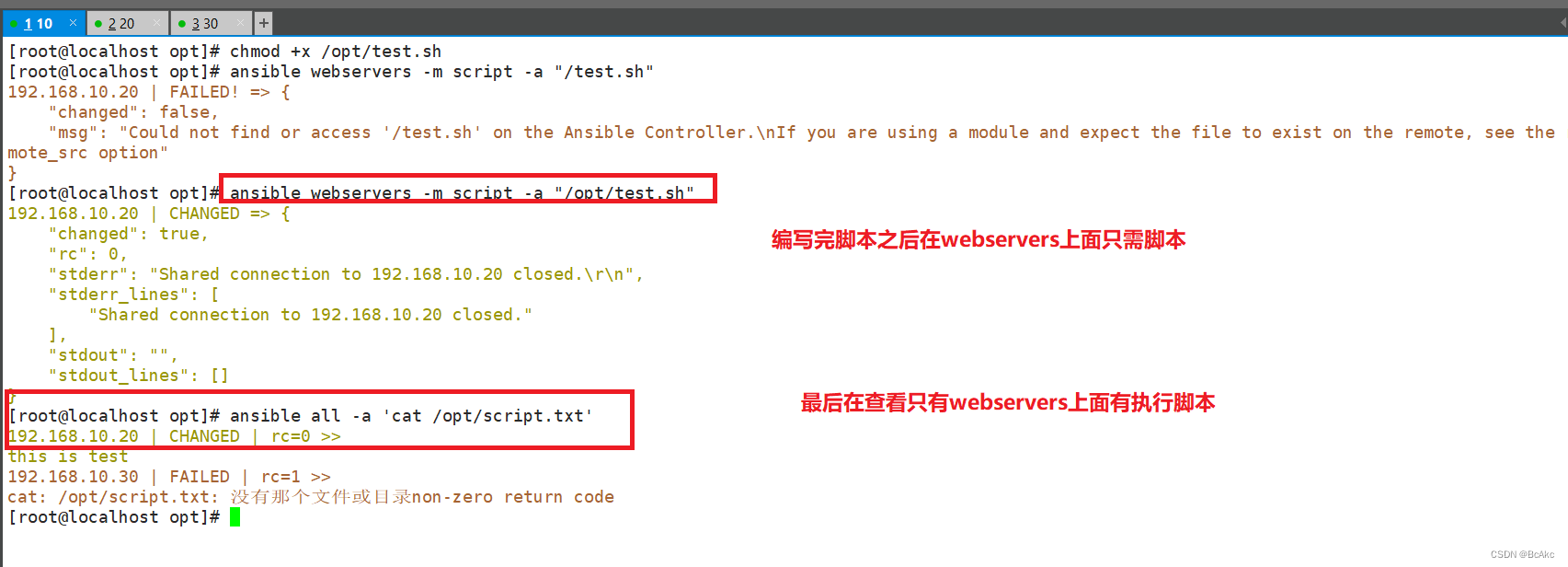
(13)yum模块
在远程主机上yum安装与卸载软件包
常用参数:name:指定要安装卸载的软件;state=present/absent,默认persent添加,absent卸载
举例:ansible webservers -m yum -a "name=httpd"

(14)setup模块
setup 模块可以获取这些信息 facts 组件收集d 被管理节点信息
参数:filter 过滤可配合正则表达式。
ansible webservers -m setup -a 'filter=*ipv4'
ansible dbservers -m setup #查看所有信息
(15) hostname模块
修改被控制端的主机名
参数:name:指定被控端的主机名
举例:
ansible webservers -m hostname -a "name=ansible"
ansible dbservers -m hostname -a "name=mysql01"
四、inventory主机清单
4.1 inventory介绍
hosts配置文件位置:/etc/ansible/hosts
Inventory支持对主机进行分组,每个组内可以定义多个主机,每个主机都可以定义在任何一个或多个主机组内。
4.2 inventory中的变量
ansible_host ansible连接节点是的IP地址。
ansible_port 连接对方的端口号,ssh连接时默认为22。
ansible_user 连接对方主机时使用的主机名,将使用执行ansible或ansible-playbook命令的用户。
nsible_password 连接时的用户的ssh密码,仅在未使用密钥对验证的情况下有效。
ansible_ssh_private_key_file 指定密钥认证ssh连接时的私钥文件。
ansible_ssh_common_args 提供给ssh sftp scp命令的额外参数。
ansible_become 允许进行权限提升。
ansible_become_method 指定提升权限的方式,例如可使用/sudo/su/runas等方式。
ansible_become_user 提升为哪个用户的权限,默认提升为root。
ansible_becom_password 提升为指定用户权限时的密码。
4.3 主机变量
[webservers]
192.168.10.20 ansible_port=22 ansible_user=root ansible_password=abs123
4.4 组变量
[webservers:vars] #表示为webservers组内所有主机自定义变量
ansible_user=root
ansible_password=abc123[all:vars] #表示为所有组内的所有主机自定义变量
ansible_port=22
4.5 嵌套组
[nginx]
192.168.10.10
192.168.10.20
192.168.10.30[apahce]
192.168.10.1[0:3][webs:children] #表示为webs主机组中包含了nginx和apache组内所有主机
apache
nginx


